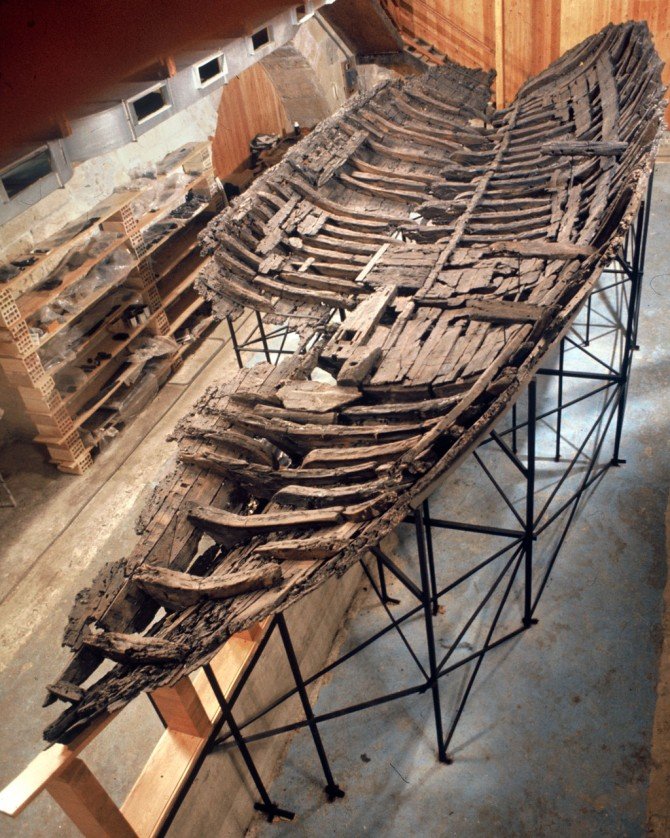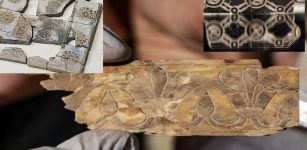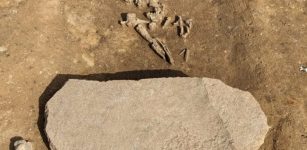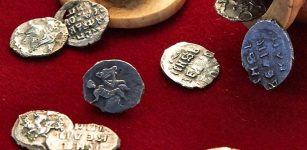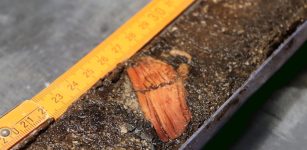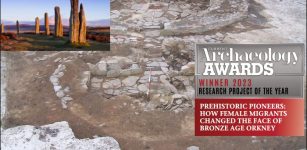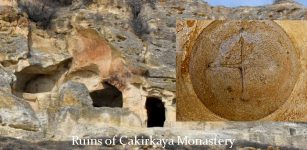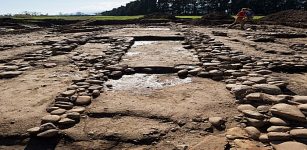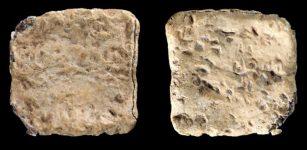Secrets Of The Famous Hellenistic-Era Kyrenia Shipwreck Revealed
Jan Bartek - AncientPages.com - Historic shipwrecks are often associated with the possibility of discovering submerged treasures on the ocean floor. However, for the Cornell research team investigating the renowned Hellenistic-era Kyrenia shipwreck, discovered off Cyprus's northern coast in the 1960s, the most valuable find was not precious metals or jewels but rather a large quantity of almonds preserved in cargo jars.
From 1967 to 1969, archaeologists excavated the Kyrenia shipwreck, which had been discovered off the north coast of Cyprus in 1965. Credit: Kyrenia Ship Excavations/Provided
The Cornell Tree-Ring Laboratory utilized these almonds, along with recently cleaned wood samples and its expertise in modeling and radiocarbon dating, to determine the most probable timeframe for the Kyrenia's sinking. Their analysis indicates that the ship likely sank between 296 and 271 B.C., with a high probability of the event occurring specifically between 286 and 272 B.C.
The Kyrenia ship is a significant archaeological discovery from the Greek Hellenistic period. Unearthed in 1965, it is notable for its well-preserved hull, making it a unique find from its era. Between 1967 and 1969, archaeologists conducted a thorough excavation of the ship and its cargo, which included a substantial collection of ceramic vessels. Following the excavation, the ship was carefully reassembled at a separate location for detailed scientific analysis.
Over the past six decades, the Kyrenia has been an invaluable resource for archaeologists and historians. It has provided crucial information about ancient shipbuilding techniques, construction methods, and maritime trade practices. The ship's importance is further emphasized by creating three replicas, which have expanded our understanding of ancient naval architecture and sailing capabilities.
Despite its significance, the exact chronology of the Kyrenia, including its construction date and the time of its sinking, has remained uncertain. Initial dating attempts relied on the artifacts found aboard the ship, such as pottery and a small collection of coins. These items led researchers to estimate that the ship was constructed and sank during the latter part of the 4th century B.C. (300s B.C.).
Kyrenia was one of the first times it was realized that this type of rich evidence from the classical world could be found largely intact more than 2,000 years later on the seabed, if you could find it,” said Sturt Manning, Distinguished Professor of Arts and Sciences in Classical Archaeology in the College of Arts and Sciences and lead author of the study.
“It was a bit of a landmark moment, the idea that you actually could dive, excavate and bring up a classical-era ship and so discover this long-past world directly. Shipwrecks are unique time capsules, and you can get amazing preservation.
Classical texts and finds at port sites already told us this era was significant for widespread maritime trade and connections all around the Mediterranean – an early period of globalization,” But the discovery of the Kyrenia ship, just under 15 meters long, likely with a crew of four, dramatically made this all very immediate and real. It yielded key insights into the practicalities of the earlier part of a millennium of intense maritime activity in the Mediterranean, from Greek through Late Antique time," Professor Manning said.
The first volume of the final publication of the Kyrenia ship project, released last year, argued the wrecking date was a little later, closer to 294-290 BCE, but the primary piece of evidence – a poorly preserved, nearly illegible coin – was not watertight.
Manning’s team, which included co-authors Madeleine Wenger ’24 and Brita Lorentzen, ’06, Ph.D. ’15, sought to secure a more precise date.
The biggest hurdle for accurately dating the Kyrenia has been another artifact, one from the 20th century: polyethylene glycol (PEG). Excavators and preservationists often applied the petroleum-based compound to waterlogged wood to prevent it from decomposing after it was lifted out of the ocean’s oxygen-free environment.
“PEG was a standard treatment for decades. The trouble is it’s a petroleum product,” Manning said, “which means that if you’ve got PEG in the wood, you have this contamination from ancient fossil carbon that makes radiocarbon dating impossible.”
Manning’s team worked with researchers at the University of Groningen in the Netherlands to develop a new method to clean PEG out of wood, and they demonstrated it on PEG-treated Roman-era samples from Colchester, England, that already had established dendrochronological (tree-ring sequence) dates.
“We removed the PEG from the wood, we radiocarbon dated it and we showed that in each case, we got a radiocarbon age consistent with the real (known) age,” Manning said. “We basically got 99.9% of the PEG removed.”
The Kyrenia was the first major Greek Hellenistic-period ship to be found with a largely intact hull. It was excavated and reassembled for scientific study. Credit: Kyrenia Ship Excavations/Provided
They used that technique to remove PEG from a Kyrenia sample that Manning and collaborators had tried, and failed, to accurately date 10 years ago. The team also now dated a tiny, twisted piece of wood that was salvaged from the Kyrenia in the late 1960s but was too small to be included in the reconstruction, thus avoiding PEG-treatment. It subsequently sat in a jar of water in a museum for 50-odd years.
The dates showed that the most recent preserved tree-rings from these timbers grew in the mid-later 4th century B.C. Because the samples did not include bark, the researchers couldn’t determine the exact date the original trees were felled, but could say the date was likely after approximately 355-291 BCE.
Working with Kyrenia’s original excavation team, the researchers examined its various artifacts, including the pottery and coins, with a focus on organic materials, including an astragalus (a sheep or goat ankle bone once used for games and divining rituals in several ancient cultures) and thousands of fresh green almonds found in some of the large amphorae, i.e., ceramic jars. These “short-lived” sample materials helped define the ship’s last voyage date.
The team applied combined statistical modeling with the dendrochronology of the wood samples to get a level of dating that was much more precise than previous efforts. The modeling identified the most likely range of dates for the final voyage to be between 305-271 BCE (95.4% probability) and most likely 286-272 BCE (68.3% probability) – several years more recent than current estimations.
But there was one big hiccup along the way. The new dates didn’t align with the international radiocarbon calibration curve, which is based on known-age tree-rings and is used to convert radiocarbon measurements into calendar dates for the northern hemisphere.
Manning took a closer look at the data behind the calibration curve, which had been assembled over many decades by dozens of labs and hundreds of scientists.
Almonds recovered from the Kyrenia helped the researchers establish, via radiocarbon dating, the timeline of the ship’s last voyage. Credit: Kyrenia Ship Excavations/Provided
He discovered that the period between 350 and 250 B.C. had no modern accelerator mass spectrometry (AMS) radiocarbon data behind it. Instead, the calibration curve in this period relied on only a few measurements conducted in the 1980s and 1990s using an older type of radiocarbon-dating technology.
With collaborators in the U.S. and the Netherlands, the team measured known-age single-year sequoia and oak samples to re-calibrate the 433-250 B.C. curve. That not only helped clarify a big spike in radiocarbon production caused by a minimum of solar activity centered around 360 B.C. but also led to important revisions to the curve around 300 B.C. – improvements critical to dating the Kyrenia.
Professor Manning anticipates the new findings will clarify the Kyrenia timeline and its cargo and help researchers use the calibration curve for very different projects.
“This revised curve 400-250 B.C. now has relevance to other problems that researchers are working on, whether in Europe or China or somewhere else in the northern hemisphere,” he said.
See also: More Archaeology News
“Half of the people who cite the paper in the future will be citing the fact that we’ve revised the radiocarbon calibration curve in this period, and only half will be saying the Kyrenia shipwreck is really important and has a much better date.”
The study was published in PLoS ONE
Written by Jan Bartek - AncientPages.com Staff Writer


